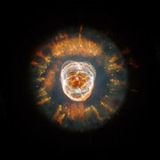
Eskimo Nebula
Encyclopedia
The Eskimo Nebula also known as the Clownface Nebula or Caldwell 39, is a bipolar
double-shell planetary nebula
(PN). It was discovered by astronomer
William Herschel
in 1787. The formation resembles a person's head surrounded by a parka hood. It is surrounded by gas that composed the outer layers of a Sun-like star
. The visible inner filaments are ejected by strong wind of particles from the central star. The outer disk contains unusual light-year long orange filaments.
NGC 2392 lies more than 2,870 light-years away and is visible with a small telescope
in the constellation of Gemini
.
on January 17, 1787, in Slough
, England. He described it as "A star 9th magnitude with a pretty bright middle, nebulosity equally dispersed all around. A very remarkable phenomenon." NGC 2392 WH IV-45 is included in the Astronomical League
's Herschel 400 observing program.
Bipolar nebula
A bipolar nebula is a distinctive nebular formation characterized by an axially symmetric bi-lobed appearance.Many, but not all, planetary nebulae exhibit an observed bipolar structure...
double-shell planetary nebula
Planetary nebula
A planetary nebula is an emission nebula consisting of an expanding glowing shell of ionized gas ejected during the asymptotic giant branch phase of certain types of stars late in their life...
(PN). It was discovered by astronomer
Astronomer
An astronomer is a scientist who studies celestial bodies such as planets, stars and galaxies.Historically, astronomy was more concerned with the classification and description of phenomena in the sky, while astrophysics attempted to explain these phenomena and the differences between them using...
William Herschel
William Herschel
Sir Frederick William Herschel, KH, FRS, German: Friedrich Wilhelm Herschel was a German-born British astronomer, technical expert, and composer. Born in Hanover, Wilhelm first followed his father into the Military Band of Hanover, but emigrated to Britain at age 19...
in 1787. The formation resembles a person's head surrounded by a parka hood. It is surrounded by gas that composed the outer layers of a Sun-like star
Sun
The Sun is the star at the center of the Solar System. It is almost perfectly spherical and consists of hot plasma interwoven with magnetic fields...
. The visible inner filaments are ejected by strong wind of particles from the central star. The outer disk contains unusual light-year long orange filaments.
NGC 2392 lies more than 2,870 light-years away and is visible with a small telescope
Telescope
A telescope is an instrument that aids in the observation of remote objects by collecting electromagnetic radiation . The first known practical telescopes were invented in the Netherlands at the beginning of the 1600s , using glass lenses...
in the constellation of Gemini
Gemini (constellation)
Gemini is one of the constellations of the zodiac. It was one of the 48 constellations described by the 2nd century astronomer Ptolemy and it remains one of the 88 modern constellations today. Its name is Latin for "twins", and it is associated with the twins Castor and Pollux in Greek mythology...
.
Historic data
The nebula was discovered by William HerschelWilliam Herschel
Sir Frederick William Herschel, KH, FRS, German: Friedrich Wilhelm Herschel was a German-born British astronomer, technical expert, and composer. Born in Hanover, Wilhelm first followed his father into the Military Band of Hanover, but emigrated to Britain at age 19...
on January 17, 1787, in Slough
Slough
Slough is a borough and unitary authority within the ceremonial county of Royal Berkshire, England. The town straddles the A4 Bath Road and the Great Western Main Line, west of central London...
, England. He described it as "A star 9th magnitude with a pretty bright middle, nebulosity equally dispersed all around. A very remarkable phenomenon." NGC 2392 WH IV-45 is included in the Astronomical League
Astronomical League
The Astronomical League is an umbrella organization of amateur astronomy societies. Currently their membership consists of over 240 organizations across the United States, along with a number of Members-at-Large, Patrons, and Supporting members....
's Herschel 400 observing program.
External links
- APOD (2003-12-07) – NGC 2392: The Eskimo Nebula

